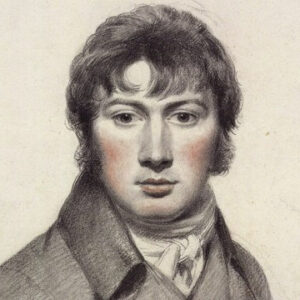John Constable was an English painter well known for his landscapes. Throughout his career, he painted extensively in his native River Stour valley, which eventually became known as Constable County. John Constable was born to Golding and Ann Constable in Suffolk, England. Golding Constable was a prosperous grain dealer who brought corn into London via his boat, ‘The Telegraph.’ Although John was his parents’ second son, he was viewed as the heir apparent to his father’s business due to his elder brother’s intellectual disability. He began working in his father’s grain business after completing his education in England, but accidental encounters with artist John Smith and collector Sir George Beaumont piqued his interest in art. He enrolled in the Royal Academy Schools (now known as the Royal Academy of Arts) and immediately began studying and copying the works of accomplished European artists. Much of his life’s work is influenced by amateur sketching expeditions to the Suffolk and Essex countryside throughout his adolescence. He married Maria Elizabeth Bicknell, a childhood acquaintance, and they had seven children together.
Childhood & Adolescence
John Constable was born in East Bergholt, Suffolk, England, on June 11, 1776, the second son of Golding and Ann (Watts) Constable.
Golding Constable was a wealthy grain dealer who had two mills in Flatford (Bergholt) and Dedham (Essex).
John attended a residential school in Lavenham and a day school in Dedham for his education. He spent several evenings as a child sketching the Suffolk countryside or ‘Skying’ (sketching different cloud formations for days).
John felt he needed to take over the family business because his elder brother was cognitively challenged. However, after viewing Claude Lorrain’s painting ‘Hagar and the Angel’ at Sir George Beaumont’s residence and meeting professional artist John Smith, he was encouraged to pursue art.
John Constable’s Career
John Constable joined the Royal Academy Schools (London) in 1799 after his father agreed to provide him a small stipend to study art.
At the Royal Academy, he began studying and reproducing the works of historical artists like Thomas Gainsborough, Claude Lorrain, and Annibale Carracci, among others, while also taking life classes and anatomical dissections.
In 1802, the Great Marlow Military College offered John Constable the position of drawing master, but he declined because he desired to continue sketching landscapes. He opened his first painting show at the Royal Academy the following year.
He married Maria Elizabeth Bicknell in 1816 at an English Anglican church in London, and the pair honeymooned at Weymouth and Brighton. There, John was inspired by the waves to create new techniques for dazzling colors and vibrant brushwork.
He spent the next few years wintering in London and summering at East Bergholt, where he sketched. He even began painting portraits for financial security, including the occasional religious portrait.
In 1819, he sold ‘The White Horse,’ his first large-scale painting (about 6 feet). His other picture, ‘The Hay Wain’ (a scene from Flatford Mill), won a gold medal at the 1824 Paris Salon.
He achieved tremendous notoriety and popularity in France, where he sold twenty paintings in a few of years. However, in 1825, he fell out with John Arrowsmith (his French dealer) for a variety of reasons and was unable to sell his paintings there.
Despite his lack of success in his native England, he vehemently opposed traveling worldwide to market his work.
John utilized the £20,000 inheritance from his wife Maria just before she died in 1828 to pay for the engraving of several mezzotints of some of his landscapes in preparation for publication. However, the published folios were a failure, failing to attract a sufficient number of subscribers.
His long-standing association with the Royal Academy was maintained when he was elected an Associate in 1819, a member in 1829, and a Visitor in 1831.
He conducted a series of lectures on landscape painting at the Royal Institution, where he made three points: first, landscape painting is both scientific and lyrical; second, art cannot be produced just by imagination; and third, no great painter has ever been self-taught.
He presented his final lecture at the Royal Academy in 1835, describing it as the “cradle of British art.”
His Significant Works
Without a doubt, John Constable’s oil painting ‘The Hay Wain’ is his magnum opus and one of the most popular English works. The canvas painting depicts a rural landscape on the River Stour between the English counties of Suffolk and Essex, near the Flatford Mill, with three horses carrying a hay wain (huge farm cart) over the river as the major focus. Although it is regarded as one of the best British paintings today, it failed to find a buyer at its 1821 showing.
Awards and Accomplishments
John Constable’s painting ‘The Hay Wain’ drew little attention in London, but caused a sensation in France, earning it a gold medal at the 1824 Paris Salon from Charles X of France.
Personal History and Legacies
In 1816, John Constable married childhood friend Maria Elizabeth Bicknell. They had seven children together: John Charles, Maria Louisa, Charles Golding, Isobel, Emma, Alfred, and Lionel. Maria Elizabeth died of TB in 1828.
John Constable died on March 31, 1837, of heart failure and was buried alongside his wife at St. John-at-Hampstead.
Estimated Net worth
John Constable is one of the wealthiest painters and is ranked among the most popular. John Constable’s net worth is estimated to be $1.5 million, based on our analysis of Wikipedia, Forbes, and Business Insider.


